Paul McCartney, arguably the most prolific Beatle, not only did he help shape the face of modern music with his original project but he has also written some of the greatest songs from the past 60 years. Guinness Book of World Records even recognizes McCartney as the “most honored composer and performer in history!”
Throughout his career, Paul McCartney has been nominated for a whopping 79 Grammy Awards, won 18, was inducted twice into the Rock and Roll Hall of Fame, earned an Academy Award in 1971, and was even knighted by Queen Elizabeth II for his services to music.
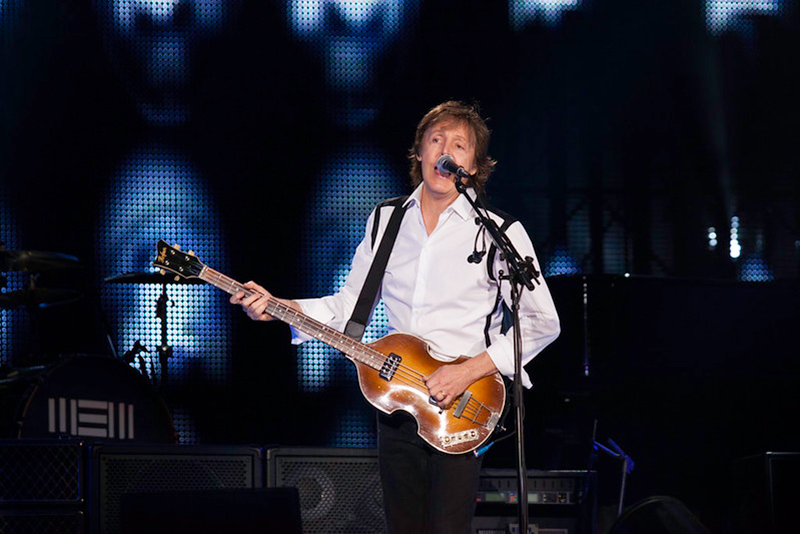
Additionally, Macca’s longevous career has seen him evolve from a solid bass player to a powerhouse of a multi-instrumentalist. Of course, becoming perhaps the greatest performer and songwriter of all time requires at least some equipment. Let’s dive into the basses, guitars, and gear Sir Paul McCartney has used over the years.
What Bass Did Paul McCartney Play?
Paul McCartney is most known for playing the Höfner 500/1 “Violin” or “Cavern” Bass guitar which was one of the primary instruments of his tenure with The Beatles. He’s also played a wide range of other bass and six-string guitar models throughout his storied career.
See the full list of Paul McCartney bass guitars, electric guitars, acoustic guitars, and other gear below.
1961/1963 Höfner 500_1

| Finish | Sunburst |
| Years Used | 1961 to Present |
McCartney and this “cavern”, or “violin” bass as it’s sometimes referred to, go way back to the very beginning of his career, and while it’s been subject to some cosmetic modifications over the years, one can always recognize the “Paul McCartney Bass guitar”. It’s been used to record everything from Beatles’ world-changing hits to Wings head-bobbers and beyond.
Back in 1961, the Beatles were playing a few gigs in Hamburg Germany. The original bassist, Stu Sutcliffe, decided to exit the band, leaving a bass-sized hole in the band. Back then, McCartney played mostly piano, but he really wanted to join the band. Since he was going to switch from piano to bass, he needed to pick up a new instrument.
Paul headed to a little music shop in the center of town and saw a unique-looking instrument in the window. It was an electric bass, but it looked like a violin. He went into the store and picked up a 1961 Höfner 500/1 bass for the equivalent of $45 by today’s standards. This was his very first bass guitar.
Paul’s original 1961 Höfner was a right-handed model that he restrung upside down. It featured a semi-acoustic hollow maple body, flamed maple back and sides, an arched spruce top, rosewood fretboard with 22 frets, Pearloid pickguard, dual Höfner Diamond humbucker pickups, two volume control knobs, and two toggle switches for bass, treble, and solo settings. The early Höfner basses had the two pickups, one in the neck and another in the mid position with nothing on the bridge position.
The 1961 Höfner 500/1 accompanied McCartney as his primary instrument for the first few years with the Beatles. He used it exclusively when the Beatles played their iconic Cavern Club performances in 1961—which earned the bass its nickname, the “Cavern Bass”—and was also used in early Beatles recordings, including their first single “Love Me Do” and the first two albums, “Please Please Me” and “With the Beatles”.
As The Beatles got bigger and bigger in the early ‘60s, Höfner wanted to say thank you to Paul McCartney for giving them so much exposure. So, in 1963, they gifted him with a brand-new Höfner 500/1 that featured a few new modifications.
The major change between the 1961 and 1963 models is in its setup. Instead of the “Diamond” pickups, Höfner installed new “Staple” versions on both the neck and bridge positions (no more middle and neck).
Once McCartney received his 1963 Höfner 500/1, it immediately became his primary bass guitar, nevertheless, it would be regularly rotated with his original piece. He used it right away to record “I Want to Hold Your Hand,” and it joined him on stage for every Beatles live performance, including the famous Ed Sullivan Show performance that launched Beatlemania in the U.S.
Other than removing the pickguard in 1966, McCartney’s 1963 500/1 received no other modifications over the years. He continued to use it throughout the rest of his time with the Beatles, including the iconic final performance on the rooftop of Apple Records in 1969.
Once the Beatles split in 1970, Paul put his 1963 Höfner away for over two decades. In 1989, Elvis Costello asked McCartney to get the iconic bass back out of the closet to record the “Flowers in the Dirt” sessions. Luckily for everyone, Paul complied and used his 1963 Höfner for both the recordings and live performances. After the Flowers in the Dirt was finished, the bass was never put away again. Paul still uses it as his primary bass on most recordings and live shows. Many compare it to Charlie Chaplain’s cane: If you see Paul McCartney, you just expect to see his Höfner bass, too!
Unfortunately, his original Höfner was stolen from EMI studios in 1969, along with a few of George Harrison‘s guitars. The iconic 1961 Höfner 500/1 that was responsible for so much music history was never recovered and is still at large today! It could be considered the music world’s “Most Wanted” instrument of all time.
1964 Rickenbacker 4001S

| Finish | Fireglo/Psychedelic/Natural |
| Years Used | 1965 to 1981 |
In 1965, the Beatles were set to play the Hollywood Bowl. But before they took the stage, they were met by John Rickenbacker—the son of Adolph, founder of Rickenbacker guitars—who had a special gift for the fabulous four. He gave Paul McCartney a brand-new 1964 Rickenbacker 4001S bass.
The 4001S was considered a “deluxe” version of the standard Rickenbacker production bass. Instead of one pickup, the 4001S had two single-coil Horseshoe pickups for even more power. The body featured a neck-through design, twin truss rods, four control knobs (two for volume and two for tone), triangle fret inlays, a three-way selector switch, and dual output jacks for that famous Rick-O-Sound.
McCartney’s 4001S was a left-handed version with a brilliant Fireglo finish (which is red sunburst for anyone who doesn’t speak Ric). While the Rickenbacker 4001S didn’t get much use right away, it became instrumental in the latter part of McCartney’s time with the Beatles for its big bottom tone that was so different from the flat hollow-body tone of his Höfner 500/1. The first major appearance of the Rickenbacker was in promotional videos for Sgt. Pepper’s Lonely Hearts Club Band, for which it was refinished with a colorful psychedelic paint job.
McCartney used his now-colorful Rickenbacker to record many songs for Sgt. Pepper, but he switched back to his Höfner and a Fender Jazz bass for The White Album and Let It Be sessions. He did, however, pull out the old Rickenbacker for the Abbey Road sessions in 1969. You can hear it in the iconic bass line at the beginning of “Come Together.”
After the Beatles split in 1970, McCartney stripped his old Rickenbacker of its psychedelic paint job, leaving it with its natural blonde wood finish. It then became his primary bass for touring and recording with his next big project, Wings. You could see the now-natural Rickenbacker on stage during virtually any Wings performance. Listen to the groovy vibes in this version of “Silly Love Songs.” This is easily one of the most iconic Paul McCartney Bass guitars of all time.
1962 Epiphone Casino
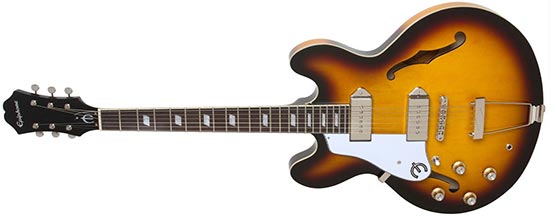
| Finish | Sunburst |
| Years Used | 1964 to Present |
In 1964, Paul McCartney was hanging out with blues player John Mayall, listening to some records. Mayall would show him all the great blues players of the day, including Eric Clapton and BB King. What most of them had in common was that they all played hollow-body guitars to get their particular tone. Of course, Paul McCartney had to get some of that for himself, so he went out and picked up a 1962 Epiphone Casino.
The Epiphone Casino debuted in 1961, shortly after Gibson acquired the brand. It was made essentially a full hollow-body version of the wildly popular ES-335. It featured dual P90 single-coil pickups, four adjustment knobs, a three-way selector switch, an adjustable bridge, and a wire tailpiece.
McCartney’s Casino was an early 1962 model, which still had a Gibson-style headstock (it was before the Epiphone headstock was designed). Instead of the standard tailpiece, it also had a Bigsby tremolo. Of course, since McCartney plays left-handed, he had to swap the pickguard to the other side of the pickups and adjusted the bridge to work with the upside-down string intonation. He also moved the strap pin to the other side of the guitar. He never swapped the Bigsby, so whenever you see him play his Epi, the tremolo arm is on the “wrong” side.
Shortly after Paul got his Casino, he took it to a Beatles practice where both George Harrison and John Lennon tried it out. They instantly fell in love and had to go get Casinos of their own. They each bought matching 1964 Epiphone Casinos with sunburst finishes, which gives the Casino the unique distinction of being the only guitar model owned by all three guitar-playing Beatles.
Paul McCartney loved his Casino, and it instantly became his primary guitar when playing with the Beatles. Although he only used it in recordings (he had to play bass in live shows), Paul’s Epi made countless appearances on records, including the solos for “Taxman,” Drive My Car,” and “Paperback Writer.”
Even after the Beatles split in 1970, McCartney continued to use his old Epiphone Casino as his primary electric guitar. According to him, “If I had to pick one electric guitar, this would be it.” The only alteration he has made to the guitar over the years is to remove the pickguard. You can still see this guitar in action at modern Paul McCartney concerts. One of its most notorious uses, was back in 2006 when Paul gave this Beatles classical piece a comeback in Abbey Road.
1964 Epiphone FT-79 Texan
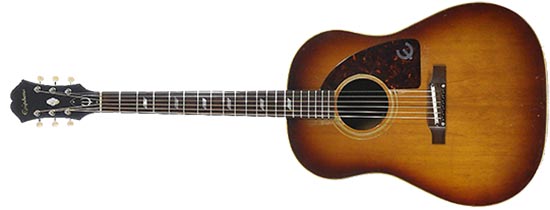
| Finish | Natural Sunburst |
| Years Used | 1964 to Present |
At the same time, he was shopping for his Epiphone Casino in 1964, Paul McCartney also picked up an Epiphone acoustic guitar called a Texan, known as the FT-79.
The Epiphone FT-79 had been produced by Epiphone long before they were acquired by Gibson, with the earliest model coming out in 1942. Once Gibson bought Epiphone, the Texans were produced in Kalamazoo, Michigan until about 1970.
Paul McCartney’s Texan was a 1964 model that featured a solid mahogany body with a solid sika spruce top. The rounded shoulders were similar to the other dreadnaught acoustics of the time, specifically the Gibson J-45. The main difference between the Texan and the J-45 is that the Texan had a slightly longer scale. It also had an adjustable bridge to help with intonation.
The only alteration McCartney made to the guitar was to add a Fishman Matrix Infinity pickup system, so he could actually be heard at concerts.
Of course, since he’s left-handed, Paul McCartney flipped the saddle and the nut, so he could restring the guitar upside-down. He used his Epi Texan to record the iconic Beatles song “Yesterday.” You can even see the guitar in action in this 1965 performance from Studio 50 in New York City. McCartney continued to use the guitar throughout the rest of his career, and you can still see it in shows today (if you’re lucky)!
When playing a concert at the Red Wings stadium in Detroit back in 1976, McCartney stuck a Red sticker just under the bridge on his Texan, which still remains to this day.
1957 Framus Zenith Model 17
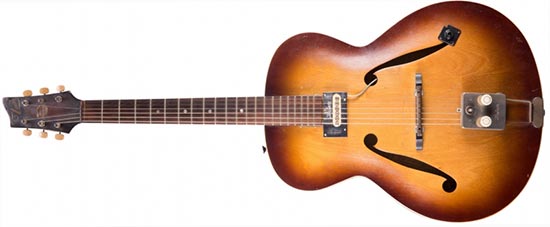
| Finish | Natural Sunburst |
| Years Used | 1957 to 1961 |
Paul McCartney didn’t start his musical journey as a guitar player. In 1956, on his 14th birthday, Paul’s dad bought him a trumpet. The trumpet was a great instrument, but with the Skiffle craze hitting the UK and Elvis Presley bringing rock and roll into the mainstream, the young Paul decided he didn’t want to play the trumpet. He wanted to be able to play and sing at the same time, so he asked his dad if he could trade it for a guitar.
With his dad’s permission, the young McCartney headed to a local music shop and traded his trumpet for a Framus Zenith Model 17 acoustic guitar. Officially, the Zenith was manufactured by the German company Framus, but it was imported to Britain by a company called Boosey & Hawkes, which is why McCartney’s Model 17 had a B&H decal on the headstock.
The Framus Model 17 was an arch-top acoustic guitar with f-holes, raised bridge, metal tailpiece, and white pickguard. McCartney’s Framus had a sunburst finish.
Once he got it home, McCartney couldn’t figure out how to play the guitar. It just felt weird in his hands. One day, he saw a picture of Slim Whitman, an American folk singer, who happened to be left-handed. McCartney decided to try playing the guitar upside-down, so he flipped the strings and gave it a shot. McCartney never played a guitar right-handed again!
The 1957 Framus Zenith Model 17 became McCartney’s primary guitar during his learning years. He even played it around town once he joined the skiffle craze in Britain. This is also the guitar McCartney played when he met John Lennon and wrote some of his earliest songs, including “When I’m 64.”
McCartney used his original Model 17 until around 1961 when he became the bassist for the Beatles and the band went on their first trip to Hamburg.
Since Paul McCartney never gets rid of his instruments, he still has his old Model 17 hanging in his studio. In the Beatles’ “Anthology” video, Paul even plays “Twenty Flight Rock” on his very first guitar—though, it looks a bit different than it did in the ‘60s. At some point, he removed the pickguard and finish to leave nothing but the natural wood behind.
Gibson Les Paul
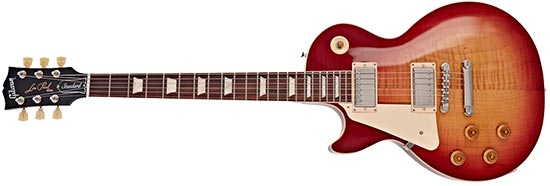
| Finish | Goldtop/ Sunburst |
| Years Used | 1980 to Present |
Although George Harrison was the only one to play a Les Paul in the Beatles, Sir Paul McCartney did pick up this iconic model in the latter part of his career. He was primarily a bassist in his time with Wings, but McCartney frequently picked up a guitar in many of his solo tours from the 1980s on.
Over the years, McCartney has used several Les Pauls, including a few extremely rare vintage models:
- Left-handed sunburst 1960 model (one of two ever made)
- 1957 Goldtop
- Black Gibson Les Paul Custom Lite
One of McCartney’s most-played Les Pauls is a custom model that has been dubbed the “Crowd Goes Wild” Les Paul. It was built specifically for McCartney for the International Day of Happiness in 2007 and was used extensively on his solo album Memory Almost Full. It features a hand-painted top covered in cartoon characters of every nation and religion with their hands in the air over a bright red background. It also has a character on the headstock playing a red left-handed Les Paul.
The Crowd Goes Wild LP was even made into a ten-foot sculpture for Gibson’s Guitartown Charity Exhibition in London—which Paul McCartney signed, of course.
The Crowd Goes Wild Les Paul has become a mainstay in McCartney’s guitar rig ever since he acquired the unique instrument. You’re almost guaranteed to see it in any live McCartney solo show. He even brought it to the iconic Cavern Club for a secret show in 2018.
Fender Telecaster

| Finish | Sunburst/ Blonde |
| Years Used | 1970 to 2020 |
Paul McCartney didn’t just stick to the bass in his career with the Beatles and Wings. He would occasionally grab a guitar to help with some lead and rhythm parts. With the Beatles, there are pictures of him playing a right-handed sunburst 1964 Fender Esquire (the predecessor to the Telecaster) while recording the album “Revolver”, and in the ‘70s, he would sometimes be seen playing a left-handed sunburst Telecaster with his band Wings.
McCartney never altered his instruments much, aside from switching them to left-handed playing. His Esquire and Telecaster both featured the standard Fender single-coil pickups that give Teles their unique sound.
A little later in his career, his wife Linda surprised him with a beautiful 1954 Fender Telecaster with a blonde finish. Ever since he got his vintage Tele, the sunburst models were nowhere to be seen. He used the blonde ’54 extensively in the latter part of his career, including to record songs like “Pretty Boys” and “Lavatory Lil.” Although it doesn’t actually make an appearance, you can see a caricature of McCartney playing a Telecaster in the music video for “Lavatory Lil.” Plus, it’s hard to mistake that iconic Tele twang!
1966 Fender Jazz Bass

| Finish | Sunburst |
| Years Used | 1966 to 1968 |
In the mid-‘60s, the Beatles were trying a lot of new ideas. Aside from the meditation, hippie culture, and perhaps a few “substances,” some new instruments also made their way into the mix. For Paul McCartney, he added a 1966 Fender Jazz Bass to his arsenal.
McCartney’s 1966 Jazz Bass was a left-handed sunburst model with a tortoiseshell pickguard. It had a solid alder body and two single-coil jazz pickups that each had their own volume control knob with a single shared master tone knob. It also had oval-shaped tuners, which were unique to the 1966 model.
McCartney used his Jazz Bass to record several songs on “The Beatles” also known as “The White Album”, including “Yer Blues,” “Glass Onion,” “While My Guitar Gently Weeps,” “Sun King,” and “Mean Mr. Mustard.”
The Beatles also had a right-handed Jazz Bass that was given to them by Fender. Since McCartney already had his left-handed bass, Lennon and Harrison both used the right-handed model to record “Helter Skelter” (Lennon) and “Back in the USSR” (Harrison).
Ampeg Dan Armstrong Plexi
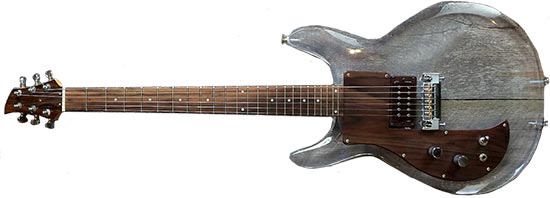
| Finish | Plexiglass Transparent |
| Years Used | 1973 |
If you want to make a statement with your guitar, you can’t go wrong with a transparent finish! In 1973, while McCartney was playing with Wings, he received the unusual Ampeg Dan Armstrong Plexi.
The Ampeg Dan Armstrong Plexi is made from a polymethyl methacrylate (PMMA) that’s completely transparent. It features a symmetrical body with double cutaways, one Bill Lawrence pickup in the bridge position, two adjustment knobs for volume and tone, and a faux-wood pickguard.
The coolest part about the guitar, aside from the finish, is its removable pickup. If you wanted to change the sound of the guitar, you could simply unclip the pickup, pull it out of the channel, and pop another one in. All the electronics synched up for an easy swap.
What makes Paul McCartney’s Plexi even more special is that it’s the only left-handed model ever produced by Ampeg. Just like McCartney himself, his guitar is also one-of-a-kind.
The only real downside about the Plexi is its weight. Because of the thick acrylic solid body, these guitars were known to weigh more than ten pounds! And you thought Les Pauls were heavy…
McCartney used his Ampeg Dan Armstrong Plexi to record the Wings song “Helen Wheels.” You can even see it in the music video when the lead guitar comes in.
Baratto CigFiddle Resonator
| Finish | Natural |
| Years Used | 2012 |
Perhaps one of McCartney’s most interesting guitars is the Baratto CigFiddle. Cigar box guitars have been around for about as long as there have been cigars. Guitarists love them for not only their unique looks, but also their interesting tone and, typically, cheap price tag.
Well, Paul McCartney isn’t immune to the allure of the cigar box guitar, so in 2012 for his collaboration with Nirvana, he brought a Baratto CigFiddle Resonator guitar on stage.
The Baratto Cigfiddle is a custom creation by luthier Matty Baratto, who has worked with some of the biggest names in the industry. He was a guitar tech for KISS, Sugar Ray, and many others. After his time as a tech, he began to build custom cigar box guitars for many big names, including Johnny Depp, Dave Grohl, and Steven Tyler. There are even rumors that Johnny Depp gifted the CigFiddle to Paul McCartney.
1952/1953 Kay M-1 Upright
| Finish | Natural |
| Years Used | 1974 to Present |
All the Beatles were huge fans of Elvis Presley. His rock and roll music was a big deal for each member and helped influence their music not only for the Beatles, but for every solo project thereafter.
Knowing that he was such a big fan, Lina McCartney (Paul’s wife) bought Paul the early 1950s Kay M-1 upright bass used by Elvis’s bassist Bill Black as a gift in 1974. Nobody is quite sure exactly the year model, but it’s either a 1952 or 1953. This bass had been an instrumental part of music history even before the Beatles played their first note!
Bill Black’s M-1 is a six-foot-tall upright concert bass with a gold finish and “dashing” white trim. It’s very hard to miss! Even after all the years, it still sounds as good as it did when it backed Elvis in the ‘50s and ‘60s. When McCartney added it to his collection, he didn’t just stick it in his house as a trophy. He actually took it to the studio!
Paul McCartney used his vintage Kay M-1 to record the newest Beatles song “Real Love” in 1995 with surviving bandmates George Harrison and Ringo Starr. He also used it for a few songs on his 2020 album McCartney III, including “Pretty Boys” and “Women and Wives.”
If you want to see this incredible bass playing the songs it was meant to play, check out this video of Paul McCartney covering Elvis’s “Heartbreak Hotel” at a solo show in 2017.
Timetable Showing Each Bass and Guitar Paul McCartney Has Played Throughout His Career
| Make | Model | Color/Finish | Years |
|---|---|---|---|
| Framus | 1957 Zenith Model 17 | Natural Sunburst | 1957 to 1961 |
| Höfner | 1963 500_1 | Sunburst | 1961 to Present |
| Epiphone | 1962 Casino | Sunburst | 1964 to Present |
| Epiphone | 1964 FT-79 Texan | Natural Sunburst | 1964 to Present |
| Rickenbacker | 1964 4001S | Fireglo/Psychedelic/Natural | 1965 to 1981 |
| Fender | 1966 Jazz Bass | Sunburst | 1966 to 1968 |
| Fender | Telecaster | Sunburst/ Blonde | 1970 to 2020 |
| Dan Armstrong | Ampeg Plexi | Plexiglass Transparent | 1973 |
| Kay | 1952/1953 M-1 Upright | Natural | 1974 to Present |
| Gibson | Les Paul | Goldtop/ Sunburst | 1980 to Present |
| Baratto | CigFiddle Resonator | Natural | 2012 |
Paul McCartney Amps Overview
Beatles fans weren’t the quietest bunch, and neither are crowds at Wings or Paul McCartney solo concerts either. To project sound to the masses, Paul needs some powerful amps. Like many British rockers, he generally turns to Vox amps, but he’s also been known to use a few other brands like Mesa-Boogie and Fender. Here’s a list of the amps Paul McCartney has used over the years.
Vox T60
In the early ‘60s, if you were a bassist who wanted to play Vox amps (and who didn’t?), you had two choices: the AC15 bass or the AC30 bass. No matter which you chose, it came with a Vox speaker cabinet that was basically built for guitars, so it had a tendency to cancel bass response.
Around 1962, Vox started to develop a line of amps specifically for basses. Their first experiment into solid-state bass amps was the Vox T.60. This brand-new solid-state amp greatly reduced the power output required by many tube bass amps, so they could keep the box relatively small. It pumped out about 30 to 40 watts of power with two inputs and three tone controls.
The T.60 head typically pushed a similar 2×15” speaker cabinet as the Vox AC30 bass, but with the bass-specific head, it provided much more low-end power.
Paul McCartney used the Vox T.60 for a while, but unfortunately, the amp had a tendency to overheat. After a few issues, McCartney swapped out the T.60 for an AC30 head but kept the T.60’s more bass-friendly speaker cabinet.
Vox AC100
As Beatles crowds got louder and louder, Paul McCartney needed an amp that could send his wonderful bass sound all the way to the fans in the back. In 1964, Vox came up with a solution: the AC100.
The AC100 is a rocking 100-watt amp designed to push as much guitar sound as possible as far as possible, no matter how many noisy fans are in the way. Paul McCartney was one of the first to use the AC100, still powering his T.60 speakers. At the time, his bandmates John Lennon and George Harrison were both outfitted with Vox AC50 amps. Eventually, three of the Fab Four would all have AC100s of their own.
Once Paul McCartney got his hands on the AC100, the pair become inseparable. McCartney has used the AC100 as his primary bass head for over 50 years and shows no signs of stopping. Today, he typically takes the stage with two Vox AC100 heads powering two Mesa-Boogie Standard PowerHouse Bass cabinets.
Paul McCartney also uses two hand-wired Vox AC100 amps pushing Vox 4×12 BN cabinets to power his guitar rig. After all, you can’t make that iconic Beatles sound without a whole lot of Vox behind you!
Mesa-Boogie Strategy Eight 8:88
Sometimes, the Vox amps don’t give Sir Paul all the bass power he’s looking for. To add a little more low-end into the mix, he uses a Mesa-Boogie Strategy Eight 88.
The Mesa-Boogie Strategy Eight 88 is a bass powerhouse. It features an all-tube head with a three-way wattage selector switch and a shapable preamp, so the player can craft exactly how they want to sound.
Paul McCartney uses the Strategy Eight 88 in conjunction with his tried-and-true Vox AC100s to beef up his bottom-end mix.
Fender Bassman
In the mid-1960s, the Beatles were going through a bit of a creative renaissance. Instead of the head-bobbers of the past like “I Want to Hold Your Hand,” they were writing songs that some might consider a bit more offbeat compared to their older material.
One part of that change was an amp swap. Although he still used his prized Vox amps, Paul McCartney started to use a Fender Bassman around 1965, and it became his primary amp all the way through mid-1967.
The Fender Bassman is powered by four 7025 preamp tubes that push 50-watts of power through four 10” Utah speakers. Although the Utah speakers aren’t necessarily considered the best by many standards, the Beatles all fell in love with the amp and used it to record almost every album from Rubber Soul on.
What you might not know is that Paul McCartney’s 1964 Fender Bassman is actually the most recorded amp the Beatles ever used. Not only was it Paul’s primary amp for years, but George Harrison and John Lennon used it as their guitar amp, too. George Harrison even took it over as his primary amp once McCartney switched back to Voxes around 1967.
Elpico AC55 “Little Green Amp”
When Paul McCartney was 14 years old, he picked up a green Elpico AC55 he called the “Little Green Amp.” This was his very first amp, and it would carry him through the first few years of his time with the Beatles.
The Elpico AC55 is a small amp that was made around 1956. It’s powered by six tubes, had a built-in preamp, and a tremolo effect. It was originally designed to amplify two microphones and a gramophone, but McCartney used it as a guitar amp.
While most major musicians trade up their original equipment once they get the means, Paul McCartney never parted with his very first amp. He still has his original Elpico AC55 and even showed it off when he was interviewed by The Mirror in 2020. Occasionally, he’ll still plug into the old amp to reminisce about the old times.
Paul McCartney Pedals and Effects Overview
Back in the late ‘50s and early ‘60s when Paul McCartney was getting his start in music, effects pedals weren’t really a big deal. They barely even existed! Although Sir Paul doesn’t use many effects, he does have a few pedals he carries around on the road. Here’s a rundown of Paul McCartney’s pedalboard.
Mellotron
While it might not be a guitar, the Mellotron has been an important instrument for both Paul McCartney and the Beatles.
The Mellotron is an early synthesizer that uses tapes instead of digital samples. Rather than circuit boards and memory cards, actual tapes played every time you pressed a key. If you wanted to change the sound a keystroke made, you could swap out the tape.
Back in the mid to late ‘60s, the Mellotron was a relatively new invention. Mike Pinder was a tester for Streetly Electronics, the company that made the Mellotron. He was immediately impressed with the capabilities of the instrument and introduced it to both John Lennon and Paul McCartney. Both of the Beatles took to the instrument and were some of the first adopters of the Mellotron.
They immediately took it into the studio and used it to record the famous intro to “Strawberry Fields Forever.” To get the sound, McCartney used the flute patch setting and played the tapes in reverse. He continued to use the Mellotron to record several songs for Magical Mystery Tour in 1967 and The Beatles (The White Album) in 1968. McCartney even continued to use the Mellotron sporadically throughout his solo career.
If you want a quick demonstration of how the Mellotron works, check out this video from 2011 of Paul McCartney showing off everything it can do (and how he made the “Strawberry Fields” intro).
Custom Pete Cornish Effects Unit
The most important effect on Paul McCartney’s pedalboard is a custom effects unit built especially for him in the 1980s by a man named Pete Cornish.
Since Paul is a multi-instrumentalist, he needs a pedalboard that can keep up with all his instrument swaps. His Custom Pete Cornish Effects Unit has a guitar/bass switch to make switching instruments a breeze. It also has a few built-in effects, including distortion and chorus, along with a mute switch and a tuner. It’s essentially an all-in-one pedal that lets McCartney control his tone no matter which instrument he’s playing.
Höfner Time and Time Again
Every legendary musician needs a good delay pedal. When Paul McCartney needs to add some echo to his tone, he turns to his favorite bass manufacturer Höfner.
The Höfner Time and Time Again is an all-analog delay/echo pedal that provides a completely authentic vintage sound. You can control the delay time anywhere from 30 to 300 milliseconds to produce anywhere from quick slapback tones to long repeating echoes. To make it even better, every Time and Time Again pedal is completely handmade.
The Time and Time Again pedal has been a mainstay on Paul McCartney’s pedalboard for years.
Gary Hurst Tone Bender
The Gary Hurst Tone Bender was one of the very first fuzz pedals, based on the true original Maestro Fuzz-Tone. Paul McCartney used the Gary Hurst Tone Bender throughout his time with the Beatles to occasionally add a little oomph to his bass tone. He also used it for some of his lead guitar parts, like on his solo for “Taxman” using his favorite electric guitar, his 1962 Epiphone Casino.
Wrap Up
Paul McCartney grew up in a musical household, his father, a jazz musician, taught him the fundamentals from a very early age. When he was about 14 years old, he got his first acoustic guitar and immediately started learning the popular songs of the time and even writing his own music. Some of McCartney’s earliest influences include Little Richard, Buddy Holly, and Elvis Presley.
In 1957, he joined a band called the Quarrymen with John Lennon that eventually evolved into the Beatles. Together with Lennon, George Harrison, and later Ringo Starr, the Fab Four would go on to become arguably the most successful rock band in history. With little surprise, the broad majority of their chart-topping songs were either written or co-written by Paul McCartney.
After the Beatles broke up, McCartney didn’t waste any time getting back to music. He immediately went on to start his solo career. He released his first solo album, McCartney, and formed his second band Wings in 1970, the same year of the Beatles split!
He continued to have a very successful career with Wings all the way through 1981. From there, he continued his solo career and collaborated with countless other rock legends, including Dave Grohl, Michael Jackson, Elvis Costello, and Stevie Wonder, only to name a few.
Despite his palpable status, Paul McCartney remains an active member of his community in his hometown of Liverpool, funding nearly over 45 different charities and promoting countless benefit concerts as well as events. Even as he enters his eighth decade, Paul McCartney is still playing shows and doing what he loves. Hopefully, he can continue to shape music history for many years to come!

My name is Chris and I’ve had a passion for music and guitars for as long as I can remember. I started this website with some of my friends who are musicians, music teachers, gear heads, and music enthusiasts so we could provide high-quality guitar and music-related content.
I’ve been playing guitar since I was 13 years old and am an avid collector. Amps, pedals, guitars, bass, drums, microphones, studio, and recording gear, I love it all.
I was born and raised in Western Pennsylvania. My background is in Electrical Engineering, earning a Bachelor’s degree from Youngstown State University. With my engineering experience, I’ve developed as a designer of guitar amplifiers and effects. A true passion of mine, I’ve designed, built, and repaired a wide range of guitar amps and electronics. Here at the Guitar Lobby, our aim is to share our passion for Music and gear with the rest of the music community.

Nice list. However you’re missing two basses: in the 80’s he used a sunburst Yamaha BB1200, and later a Wal 5-string.
Fantastic article, thanks for writing it!